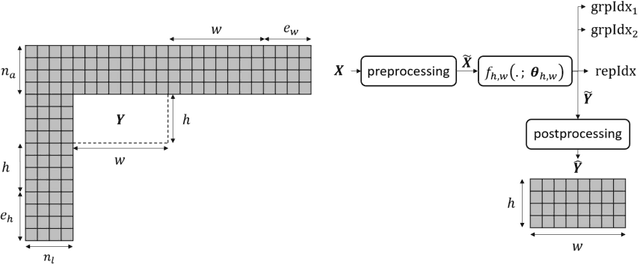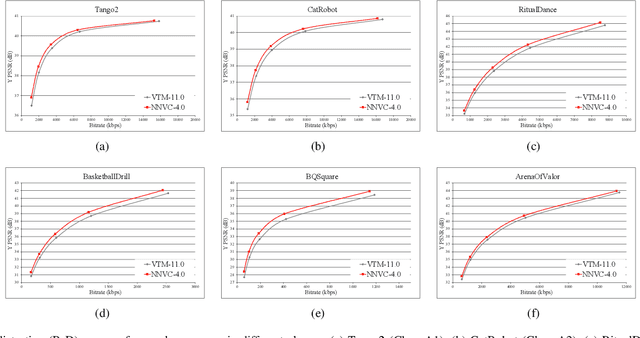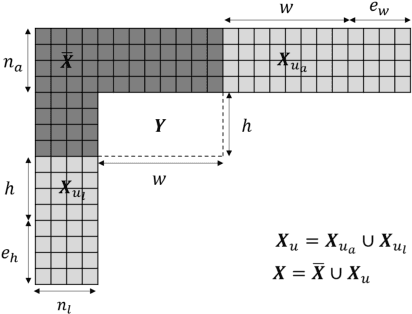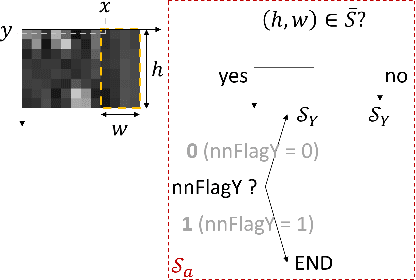Du Liu
Manifold Approximation leads to Robust Kernel Alignment
Oct 27, 2025Abstract:Centered kernel alignment (CKA) is a popular metric for comparing representations, determining equivalence of networks, and neuroscience research. However, CKA does not account for the underlying manifold and relies on numerous heuristics that cause it to behave differently at different scales of data. In this work, we propose Manifold approximated Kernel Alignment (MKA), which incorporates manifold geometry into the alignment task. We derive a theoretical framework for MKA. We perform empirical evaluations on synthetic datasets and real-world examples to characterize and compare MKA to its contemporaries. Our findings suggest that manifold-aware kernel alignment provides a more robust foundation for measuring representations, with potential applications in representation learning.
Designs and Implementations in Neural Network-based Video Coding
Sep 13, 2023



Abstract:The past decade has witnessed the huge success of deep learning in well-known artificial intelligence applications such as face recognition, autonomous driving, and large language model like ChatGPT. Recently, the application of deep learning has been extended to a much wider range, with neural network-based video coding being one of them. Neural network-based video coding can be performed at two different levels: embedding neural network-based (NN-based) coding tools into a classical video compression framework or building the entire compression framework upon neural networks. This paper elaborates some of the recent exploration efforts of JVET (Joint Video Experts Team of ITU-T SG 16 WP 3 and ISO/IEC JTC 1/SC29) in the name of neural network-based video coding (NNVC), falling in the former category. Specifically, this paper discusses two major NN-based video coding technologies, i.e. neural network-based intra prediction and neural network-based in-loop filtering, which have been investigated for several meeting cycles in JVET and finally adopted into the reference software of NNVC. Extensive experiments on top of the NNVC have been conducted to evaluate the effectiveness of the proposed techniques. Compared with VTM-11.0_nnvc, the proposed NN-based coding tools in NNVC-4.0 could achieve {11.94%, 21.86%, 22.59%}, {9.18%, 19.76%, 20.92%}, and {10.63%, 21.56%, 23.02%} BD-rate reductions on average for {Y, Cb, Cr} under random-access, low-delay, and all-intra configurations respectively.
EVD Surgical Guidance with Retro-Reflective Tool Tracking and Spatial Reconstruction using Head-Mounted Augmented Reality Device
Jul 03, 2023



Abstract:Augmented Reality (AR) has been used to facilitate surgical guidance during External Ventricular Drain (EVD) surgery, reducing the risks of misplacement in manual operations. During this procedure, the key challenge is accurately estimating the spatial relationship between pre-operative images and actual patient anatomy in AR environment. This research proposes a novel framework utilizing Time of Flight (ToF) depth sensors integrated in commercially available AR Head Mounted Devices (HMD) for precise EVD surgical guidance. As previous studies have proven depth errors for ToF sensors, we first assessed their properties on AR-HMDs. Subsequently, a depth error model and patient-specific parameter identification method are introduced for accurate surface information. A tracking pipeline combining retro-reflective markers and point clouds is then proposed for accurate head tracking. The head surface is reconstructed using depth data for spatial registration, avoiding fixing tracking targets rigidly on the patient's skull. Firstly, $7.580\pm 1.488 mm$ depth value error was revealed on human skin, indicating the significance of depth correction. Our results showed that the error was reduced by over $85\%$ using proposed depth correction method on head phantoms in different materials. Meanwhile, the head surface reconstructed with corrected depth data achieved sub-millimetre accuracy. An experiment on sheep head revealed $0.79 mm$ reconstruction error. Furthermore, a user study was conducted for the performance in simulated EVD surgery, where five surgeons performed nine k-wire injections on a head phantom with virtual guidance. Results of this study revealed $2.09 \pm 0.16 mm$ translational accuracy and $2.97\pm 0.91$ degree orientational accuracy.
A User-Centered, Interactive, Human-in-the-Loop Topic Modelling System
Apr 04, 2023Abstract:Human-in-the-loop topic modelling incorporates users' knowledge into the modelling process, enabling them to refine the model iteratively. Recent research has demonstrated the value of user feedback, but there are still issues to consider, such as the difficulty in tracking changes, comparing different models and the lack of evaluation based on real-world examples of use. We developed a novel, interactive human-in-the-loop topic modeling system with a user-friendly interface that enables users compare and record every step they take, and a novel topic words suggestion feature to help users provide feedback that is faithful to the ground truth. Our system also supports not only what traditional topic models can do, i.e., learning the topics from the whole corpus, but also targeted topic modelling, i.e., learning topics for specific aspects of the corpus. In this article, we provide an overview of the system and present the results of a series of user studies designed to assess the value of the system in progressively more realistic applications of topic modelling.
 Add to Chrome
Add to Chrome Add to Firefox
Add to Firefox Add to Edge
Add to Edge